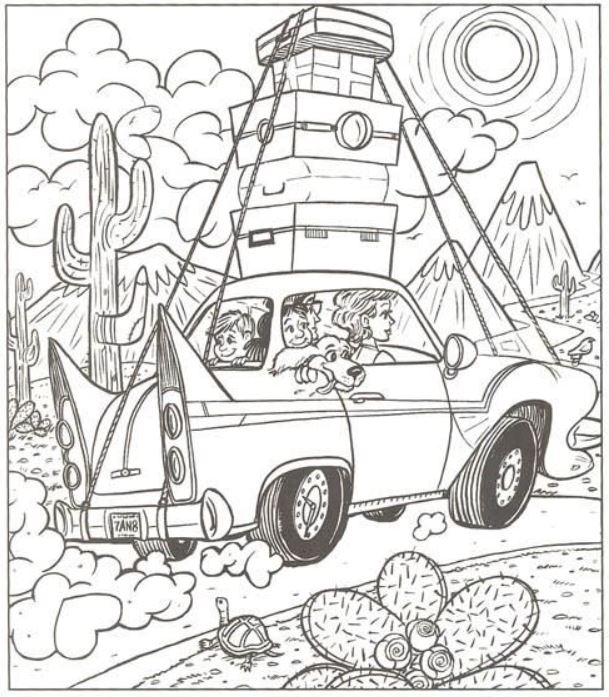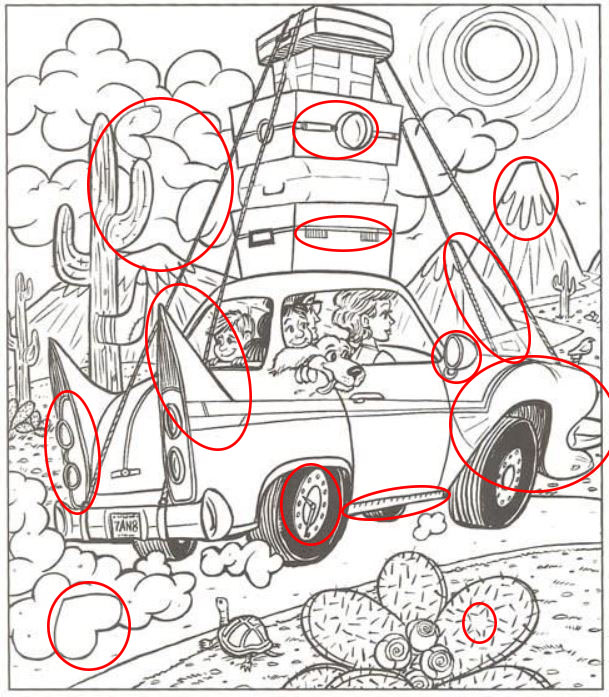Ultimate Family Road Trip Guide: Packing, Planning, and Creating Unforgettable Memories
Why Family Road Trips Are the Perfect Adventure
There’s something magical about piling everyone into the car, cranking up a favorite playlist, and hitting the open road. Road trips let families explore new places at their own pace, strengthen bonds with shared experiences, and collect memories—one rest-stop snack at a time. Unlike rigid air-travel itineraries, road trips offer flexibility: a hidden cactus field, a quirky roadside diner, or an impromptu sunset viewing can become the highlight of your journey. Ready to turn your next drive into an epic adventure? Buckle up as we explore expert tips for packing smart, planning wisely, and making your family road trip one for the history books.

Choosing Your Route: Balancing Planning and Spontaneity
Deciding where to go is half the fun. Do you crave desert vistas among towering cacti and rocky mesas, like the cartoon family’s scene suggests? Or do you dream of coastal highways, sleepy mountain passes, or historic Route 66 landmarks? Start by sketching a rough loop that includes must-see attractions—national parks, theme parks, or grandma’s house—while leaving plenty of wiggle room. Use mapping apps to estimate driving times, then add extra hours for unplanned detours: a roadside stand selling fresh peaches or a quirky museum that catches your eye. Remember, the best memories often come from unexpected stops. Aim for no more than four to six hours of driving per day to keep kids (and adults) happy and energy levels high.
Essential Packing Tips for a Hassle-Free Trip
A well-packed car keeps stress at bay and ensures everyone can find what they need on the fly. Here’s a quick checklist:
- Clothing & Layers:Pack versatile outfits for varying climates—desert days can be scorching, but nights may chill. Include hats, sunglasses, and a light jacket per person.
- Snacks & Hydration:Stock a cooler with water bottles, cut fruit, trail mix, and healthy granola bars. Toss in a few treats like cookies or chips for emergencies (and morale boosts).
- Entertainment & Comfort:Bring a mix of audiobooks, playlists, and travel games (I Spy, license-plate bingo). Neck pillows, blankets, and earbuds help everyone relax.
- Safety & Maintenance:Carry a roadside emergency kit—jumper cables, flashlight, basic tools, first-aid supplies. Check tire pressure, oil, and fluids before departure.
- Navigation & Documentation:Print or download maps of your route. Have printed hotel confirmations and any necessary passes (park reservations, pet-friendly lodging permits).
- Kids’ Essentials:Wet wipes, hand sanitizer, motion-sickness remedies, and a small backpack with coloring books or tablets. Don’t forget a travel potty or potty seat if you have little ones.
Organize these items in labeled bins or soft-sided carriers for quick access. Stash frequently used items (snacks, wipes) in the center console or under-seat compartments.

Making Pit Stops Count: Must-Do Break Ideas
Long stretches of highway can feel endless without interesting breaks. Spice up your pit stops:
- Local Diners & Food Trucks:Ditch chain-restaurants for regional specialties—roadside tacos, BBQ joints, or lavender lemonade stands.
- Scenic Overlooks & Short Hikes:Find viewpoints or quarter-mile trails to stretch legs and snap family photos. Desert landscapes, mountain overlooks, or coastal bluffs all deliver “wow” moments.
- Roadside Attractions:The world’s largest ball of twine or a giant guitar sculpture might be cheesy—but they make for memorable photo ops and laughter.
- Interactive Museums & Visitor Centers:Many state parks feature free interpretive centers with hands-on exhibits, perfect for curious minds.
- Urban Pit Stops:If you’re passing through small towns, explore local parks, historic main streets, or farmers’ markets for unique souvenirs.
Aim for breaks every two hours. A ten-minute leg stretch plus a quick snack can reset moods and prevent “Are we there yet?” complaints.
Budget-Friendly Tips: Stretching Your Travel Dollars
Road trips can be surprisingly affordable with a few savvy strategies:
- Camp When You Can:National and state park campgrounds cost far less than motels. If camping isn’t your jam, try budget-friendly motels just off the highway or vacation rentals with kitchens.
- Use Discount and Reward Programs:Enroll in hotel rewards, fuel discount cards, or grocery store membership programs for points and savings along the way.
- Cook Some Meals:Pack a portable grill or camp stove for burgers, hot dogs, or foil-wrapped veggies. Even simple breakfasts on a picnic bench cut restaurant costs dramatically.
- Free Attractions:Many scenic byways, parks, and visitor centers are free or ask only for a small donation. Take advantage of these hidden gems.
- Group Rates and Passes:If you’re visiting national parks, a $80 America the Beautiful annual pass covers entrance for the whole family for a year—ideal for multiple stops.
- Souvenir Limits:Encourage kids to pick one small memento per stop—postcards or local snacks—rather than a trinket from every tourist shop.
By mixing DIY meals, free activities, and smart lodging, you’ll keep your wallet happy and your family’s spirits high.

Staying Safe and Comfortable in Varied Climates
Crossing deserts, mountains, and coastal zones means shifting temperatures and conditions. Keep everyone safe and comfy:
- Hydration is Key:Desert drives demand constant water intake. Encourage sipping regularly, even before thirst hits, to prevent fatigue or headaches.
- Sun Protection:Wide-brimmed hats, sunscreen with SPF 30+, and UV-blocking sunglasses guard against harsh rays. Apply and reapply often—especially when windows are down.
- Temperature Control in the Car:Check your AC system; have extra fluids for the radiator. Use window shades or UV-blocking film to keep the interior cooler.
- Weather Alerts:Track forecasts for storms or heatwaves. In mountainous regions, sudden weather shifts can occur—pack rain gear and extra layers.
- Emergency Contacts & Plans:Share your route with a trusted friend or family member. Know nearest hospitals or ranger stations along your path.
- Animal and Road Hazards:Watch for wildlife crossings, especially at dawn and dusk. Slow down, use high beams when safe, and obey posted wildlife warning signs.
Preparedness keeps adventure fun, not frantic.

Capturing Memories: Tips for Documenting Your Journey
A great photo or memento can take you back to that perfect sunset or goofy highway mascot. Consider these ideas:
- Travel Journal:Encourage each family member to jot daily highlights: the silliest joke, the best meal, the biggest view. A shared journal becomes a cherished keepsake.
- Video Logs:Record a short family check-in every evening—favorite memory of the day, what you’re looking forward to tomorrow. Compile into a road-trip recap.
- Landmark Photo Challenge:Make a list of iconic shots—cactus silhouette, highway sign with destination name, family jump shot by the car.
- Nature Finds:Press wildflowers, collect smooth stones (where allowed), or sketch that perfect desert bloom you spotted.
- Polaroid Fun:Instant prints become glue-in journal pages or a quick roadside photo gallery pinned to your cooler.
These mementos preserve not just the sights but the feelings of wonder and togetherness.

Conclusion: Your Road Trip, Your Story
A family road trip is more than miles on odometer—it’s a tapestry of shared playlists, snack debates, roadside discoveries, and laughter echoing across canyons. By choosing a flexible route, packing smart essentials, sprinkling in memorable pit stops, and blending budget-savvy strategies, you transform a drive into a lifetime of memories. Stay safe by preparing for varied climates, keep spirits high with regular breaks, and document every sunrise in your journal or camera roll. Whether you’re weaving through desert cacti under a full moon or winding along coastal highways at dawn, your road trip becomes uniquely yours. So fill up the tank, map out your detours, and let the open road write your family’s next great adventure. Happy travels!